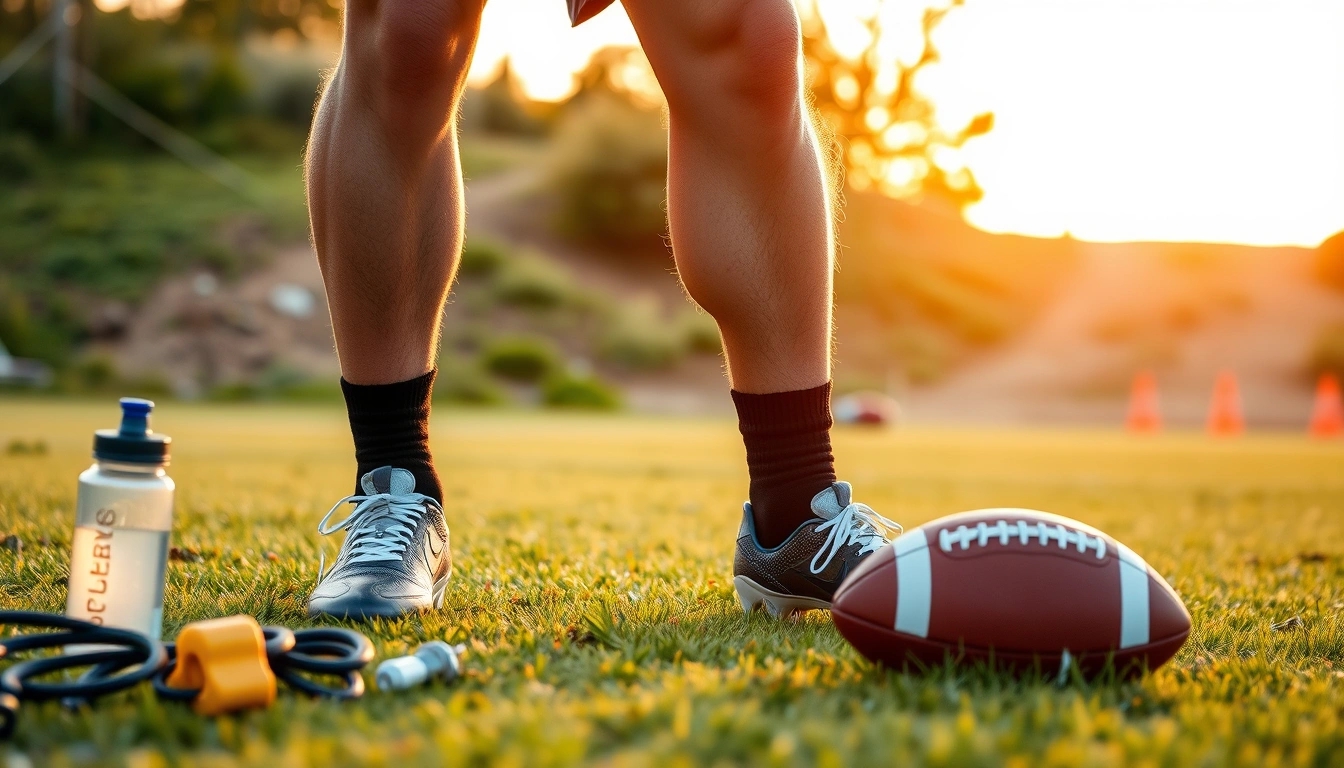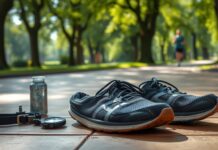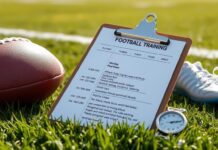Alright, so you wanna get those legs powerful enough to bulldoze through defenders but don’t have access to a fancy gym? No sweat! Building leg strength for football doesn’t always mean lifting weights surrounded by sweaty strangers and clanking machines. There’s a whole world of practical, gym-free methods that can pump up your leg game right from your backyard, living room, or even the local park.
Let’s kick things off with some bodyweight exercises. These bad boys are the bread and butter for anyone serious about leg strength but stuck without equipment. Think squats, lunges, step-ups, and calf raises. They might look simple, but do them right and consistently, and your legs will be thanking you. For example:
| Exercise | Target Muscle | Tips |
|---|---|---|
| Squats | Quads, Glutes, Hamstrings | Keep your back straight, knees behind toes |
| Lunges | Quads, Glutes | Step far enough forward, balance is key |
| Step-ups | Glutes, Quads | Use a sturdy bench or step, drive through heel |
| Calf Raises | Calves | Go slow on the way down for max burn |
Now, if you’re looking to add some explosive power (because let’s face it, football ain’t just about brute strength), jump training is your secret weapon. Plyometrics like box jumps, tuck jumps, and broad jumps train your muscles to fire fast and hard. You don’t need a fancy box—heck, even a sturdy curb or a park bench works fine. The catch? Don’t just go all out like a maniac; warm up first and focus on quality, not just quantity.
Besides moving your body, you gotta feed it right. Nutrition is often the overlooked hero in leg strength gains. No, you don’t have to chug protein shakes like a bodybuilder, but eating enough protein and carbs to fuel recovery and growth is crucial. Foods like chicken, eggs, beans, sweet potatoes, and leafy greens should be your best pals. And don’t forget hydration—muscle cramps are the worst enemy of any athlete.
- Protein sources: Lean meats, tofu, legumes
- Carb sources: Whole grains, fruits, veggies
- Supplements (optional): Creatine, whey protein, BCAAs
Recovery, folks, is where the magic actually happens. You can’t just hammer your legs day after day and expect them to get stronger. Stretching, foam rolling, and plenty of sleep are non-negotiable. Trust me, skipping rest days is like trying to drive a car without gas — pointless and harmful.
Resistance bands might seem like a gimmick, but they’re surprisingly effective for adding resistance without weights. You can loop them around your legs for lateral walks, monster walks, or leg extensions. They’re portable, cheap, and a sneaky way to hit those smaller stabilizer muscles that often get ignored.
| Resistance Band Exercise | Benefits |
|---|---|
| Lateral Band Walks | Improves hip stability and lateral strength |
| Glute Kickbacks | Targets glutes and hamstrings |
| Monster Walks | Builds hip abductors and glutes |
Finally, don’t forget agility drills. Football isn’t just about raw power; you gotta be quick on your feet, able to change direction in a blink. Ladder drills, cone drills, and shuttle runs can be done anywhere and will add that extra edge to your leg training.
So, no gym? No problem. With some creativity, dedication, and a sprinkle of patience, your legs will be game-ready in no time. Just remember — consistency beats flashiness every day of the week.
Bodyweight Exercises That Pack a Punch
Alright, so you wanna build some serious leg muscle without stepping foot in a gym or dropping cash on fancy gear? Good news: you don’t need all that fluff to get strong, explosive legs. The magic lies in bodyweight exercises — simple, effective moves you can do anywhere, anytime. No memberships, no machines, just you, your legs, and a bit of grit.
Let’s start with the classics that never fail: squats, lunges, and step-ups. These bad boys are the bread and butter of leg day, and if you do them right, they’ll hit every muscle from your quads to your glutes and hamstrings. Squats, for example, are like the Swiss Army knife of leg workouts — they strengthen your entire lower body and core. But here’s the catch: form is king. If you’re slouching or letting your knees cave in, you’re just wasting time and risking injury.
- Squats: Stand shoulder-width apart, chest up, and sit back like you’re about to plop into a chair. Keep your knees tracking over your toes, and push through your heels as you rise.
- Lunges: Step forward with one leg, lowering your hips until both knees are bent at about 90 degrees. Don’t let that front knee push past your toes — trust me, your knees will thank you.
- Step-ups: Find a sturdy bench or step, and push through your heel as you step up. This one’s killer for balance and unilateral strength, which is crucial on the football field.
| Exercise | Primary Muscles Worked | Key Tip |
|---|---|---|
| Squats | Quads, Glutes, Hamstrings, Core | Keep chest up, knees out, and weight on heels |
| Lunges | Quads, Glutes, Hamstrings | Maintain upright torso; don’t let front knee pass toes |
| Step-ups | Quads, Glutes, Calves | Drive through heel; control the descent |
Now, don’t get cocky thinking these are easy just ’cause there’s no weights involved. Bodyweight exercises can be brutal if you push the right way. For example, try adding tempo changes — slow down your descent on squats or pause mid-lunge — and you’ll torch those muscles in no time. Or, throw in some jump squats or plyometric lunges to crank up the intensity and build explosive power.
But here’s a little secret: consistency beats intensity when you’re flying solo. It’s better to bang out perfect squats and lunges three times a week than to go all-in once and then vanish for days. Mix these moves with some solid warm-ups, and don’t forget to stretch afterward — your legs will feel like they just got hit by a truck if you skip recovery.
Pro Tip:- Start with 3 sets of 12-15 reps for each exercise.- Rest 30-60 seconds between sets.- Gradually increase reps or add variations (like Bulgarian split squats) as you get stronger.
So, yeah, building football-ready legs without a gym is totally doable. These bodyweight exercises pack a punch and can transform your lower body if you give them the respect and effort they deserve. No fancy equipment? No problem. Your legs are the original machines — time to put ’em to work.
Jump Training: The Secret Sauce for Explosive Power
Alright, listen up football fanatics! If you think leg day is just about grinding squats and lunges, you’re missing out on a whole secret weapon: jump training. Yeah, those plyometric drills and explosive jumps aren’t just for basketball players or track stars. Footballers, especially the ones hustling in their backyard or local park with zero fancy gym gear, can seriously up their game by adding jump drills to their routine. No joke.
So why all the fuss about plyometrics? Well, it’s simple: these exercises train your muscles to produce maximum force in the shortest time possible. Translation? You get faster off the mark, can leap higher, and dominate those quick cuts and sprints on the field. Imagine blowing past defenders like they’re standing still — that’s the kind of boost jump training offers. Plus, it builds leg power and speed without needing a squat rack or leg press machine. Your own body weight and a patch of grass will do just fine.
- Box jumps: Find a sturdy platform or even a park bench. Jump up, land softly, step down, repeat. It’s killer for explosive strength.
- Broad jumps: Leap forward as far as you can, absorb the landing with bent knees. Great for horizontal power.
- Jump squats: Regular squats but you spring up into the air at the top. Feels brutal but packs a punch.
- Single-leg hops: Balance and power in one go. Hop forward on one leg, land steady, switch legs.
| Exercise | Main Benefit | Equipment Needed |
|---|---|---|
| Box Jumps | Explosive vertical power | Box, bench, or step |
| Broad Jumps | Horizontal power and distance | None |
| Jump Squats | Leg strength & power | None |
| Single-Leg Hops | Balance & unilateral strength | None |
Now, here’s the kicker — you don’t wanna just jump around like a headless chicken. Form matters big time. Land softly on the balls of your feet, keep your knees aligned (don’t let ‘em cave in), and use your arms to help propel you upward. Also, don’t overdo it. Plyometrics put a lot of stress on your joints, so start slow — maybe 2-3 sessions per week with plenty of rest days in between.
And if you’re thinking “I don’t have space for jumping drills,” think again. Even a small backyard or a cleared patch of sidewalk works. Heck, some of the best athletes got creative with what they had — stairs, curbs, even a sturdy park bench. The point is to get that fast-twitch muscle fiber firing, which is exactly what football demands.
Pro tip: Mix jump training with sprints and agility drills for a full-on leg power combo. Your legs will thank you, and so will your coach when you’re the one breaking away from the pack.
In the end, jump training isn’t just some fad; it’s a proven, no-nonsense way to build explosive power and speed without stepping foot in a gym. So lace up, find your spot, and get jumping. Your football legs will never be the same.
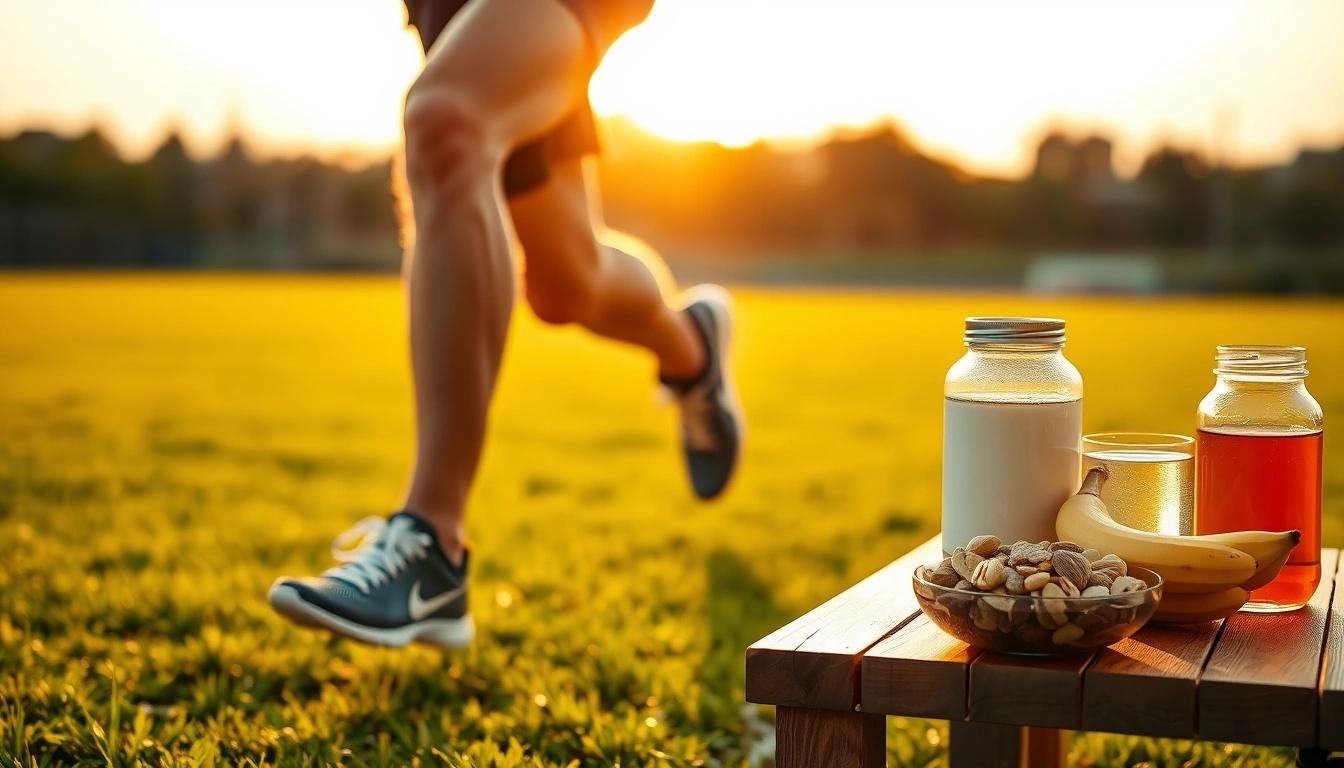
Nutrition Hacks to Fuel Leg Growth
Alright, let’s get real for a second—leg day isn’t just about grinding through endless squats or lunges. You can do all the reps in the world, but if your nutrition game is weak, your legs won’t grow stronger or recover like they should. Yeah, it’s annoying to hear, but food is basically the secret weapon in your leg-building arsenal. So, buckle up because we’re diving into what to eat (and what to maybe skip) if you want those powerful, football-ready legs.
First off, protein is king. Your muscles need it to repair and grow after all that pounding on the field or floor. Think chicken breast, lean beef, eggs, or even plant-based options like lentils and chickpeas. Don’t just slam a protein shake and call it a day, though—try to spread your intake throughout the day. Your muscles aren’t gonna soak it all up at once, trust me. Aim for around 1.6 to 2.2 grams of protein per kilogram of your body weight daily if you’re serious about building muscle.
| Food Type | Examples | Benefits |
|---|---|---|
| Protein | Chicken breast, eggs, Greek yogurt, tofu | Muscle repair and growth |
| Carbohydrates | Sweet potatoes, brown rice, oats, bananas | Energy for workouts and recovery |
| Fats | Avocado, nuts, olive oil, fatty fish | Hormone production and joint health |
Now, carbs get a bad rap sometimes, but don’t ditch them—especially on leg day. Carbs are your muscles’ favorite fuel source. Without enough carbs, you’ll feel like a zombie halfway through your workout, and recovery will drag. Sweet potatoes, oats, and bananas are your best friends here. They release energy slowly, so you don’t crash midway. Plus, they help refill your glycogen stores, which is fancy talk for the fuel your muscles burn during exercise.
Oh, and don’t forget about fats. Yeah, fats! Not the greasy junk, but healthy fats like those found in avocados, nuts, and fish. They’re crucial for hormone production, including testosterone, which plays a big role in muscle growth. Plus, they help keep your joints happy, which is important when you’re pounding the pavement or field.
- Supplements? Sure, but don’t get obsessed. Whey protein, creatine, and BCAAs can help, but they’re not magic bullets. Focus on whole foods first.
- Hydration matters. Water is often overlooked, but dehydration can kill your performance and recovery. Drink up, especially on intense training days.
- Timing is key. Try to get a mix of protein and carbs within 30 minutes after your workout to kickstart recovery.
Recovery food is just as important as pre-workout fuel. Your legs need nutrients to rebuild stronger, so don’t make the rookie mistake of starving yourself or eating junk after training. Think of it like this: you wouldn’t expect a car to run well without good fuel, right? Same goes for your legs.
Example Post-Workout Snack:- 1 medium banana- A scoop of whey protein mixed with water or milk- A handful of almonds
In the end, building stronger legs isn’t just about what you do in the squat rack or on the field—it’s also about what you put on your plate. Eat smart, hydrate well, and don’t underestimate the power of rest. Your legs will thank you when you’re breaking tackles or sprinting past defenders.
Remember: Nutrition isn’t a one-size-fits-all deal. Experiment with what works for your body, and don’t be afraid to get a little messy along the way. After all, even the pros mess up their meals sometimes. Just keep pushing.
Recovery: Don’t Skip It, Seriously
Alright, let’s get real for a second. You’ve hammered your legs with squats, lunges, and all those jump drills till you’re practically seeing stars. But here’s the kicker: muscle growth doesn’t happen while you’re grinding away in the workout. Nope. It happens when you’re chilling, resting, and letting your body do its magic. If you’re skipping recovery, you’re basically throwing your gains out the window. So, buckle up, because recovery is your secret weapon to keep those legs game-ready and injury-free.
- Stretch It Out: Stretching isn’t just for yoga fanatics. After a tough leg day, spending 10-15 minutes stretching your quads, hamstrings, calves, and glutes can be a game changer. It helps reduce muscle tightness and improves flexibility, which means less chance of pulling something dumb next time you sprint.
- Foam Rolling: This one feels brutal but trust me, it’s worth it. Foam rolling works like a deep tissue massage for your muscles, breaking up knots and boosting blood flow. It’s like telling your legs, “Hey, relax and recover!” Plus, it’s cheap and you can do it at home or even on the sidelines.
- Quality Sleep: No, scrolling through Instagram in bed doesn’t count. Your body needs solid sleep to repair muscle fibers and crank out growth hormones. Aim for 7-9 hours of uninterrupted sleep. Think of it as your nightly tune-up for peak leg performance.
Here’s a quick table to keep your recovery game on point:
| Recovery Method | Why It Works | How to Do It |
|---|---|---|
| Stretching | Reduces muscle tightness and improves flexibility | Hold each stretch for 20-30 seconds post-workout |
| Foam Rolling | Breaks down muscle knots and enhances blood flow | Roll major leg muscles for 1-2 minutes each |
| Sleep | Repairs muscle fibers and boosts growth hormone release | Get 7-9 hours of quality sleep, avoid screens before bed |
Now, here’s a little secret: recovery isn’t just about physical stuff. Your mind needs a break too. Stress can mess with your sleep and slow down muscle repair. So, maybe ditch the “I gotta do more” attitude for a bit and embrace some chill time.
Pro Tip:- Schedule at least one full rest day per week.- Hydrate like your legs depend on it (because they do).- Use ice baths or cold showers if you’re feeling extra sore.
Look, nobody’s perfect, and sometimes you’ll want to skip foam rolling or push through tiredness. Been there, done that. But if you want those legs to carry you through the whole season without cramping up or snapping like a twig, recovery isn’t optional — it’s essential. So, next time you finish your workout, don’t just flop on the couch. Stretch, roll, sleep, and repeat. Your future self (and your legs) will thank you.
Bottom line: train hard, recover harder. Neglecting recovery is like trying to build a house without letting the cement set — it just won’t hold up when the pressure’s on. Keep your recovery routine tight, and you’ll be sprinting past defenders before you know it.
Using Resistance Bands for Added Challenge
Resistance bands might look like those flimsy rubber loops your grandma uses to hang laundry, but trust me, they’re a secret weapon when it comes to leg workouts — especially if you’re skipping the gym and still want to crush it on the football field. These bands pack a punch by adding resistance without the need for clunky weights or fancy machines. Plus, they’re portable, affordable, and versatile enough to fit into any training routine.
So, how do you actually use these bands to turn your legs into powerhouses? First off, let’s talk about the types of bands. There’s a whole rainbow of resistance levels, from light to heavy, so you can customize your workout intensity. Starting with a medium band is usually a safe bet unless you’re already a beast in the leg department.
- Side Step Walks: Place the band just above your knees or around your ankles. Now, squat down slightly and step side to side. This move targets your hip abductors and glutes, which are crucial for lateral movements on the field.
- Glute Bridges: Wrap the band above your knees, lie on your back with feet flat on the floor, and push your hips up while keeping tension on the band. This fires up your glutes and hamstrings like nothing else.
- Squats with Resistance: Add the band above your knees and perform your usual squats. The band forces your legs to push outward, activating stabilizer muscles that often get neglected.
| Exercise | Muscle Focus | Band Placement | Tips |
|---|---|---|---|
| Side Step Walks | Glutes, Hip Abductors | Above knees or ankles | Keep tension on band throughout, don’t let feet touch |
| Glute Bridges | Glutes, Hamstrings | Above knees | Drive hips up strong, squeeze at the top |
| Squats with Resistance | Quads, Glutes, Stabilizers | Above knees | Push knees outward against band |
Now, here’s a little secret: resistance bands don’t just build strength, they also improve muscle activation and joint stability. This means fewer injuries and better performance on the field. But don’t get lazy thinking bands alone will make you Hulk. You gotta push through the burn and keep challenging yourself by increasing reps, sets, or switching to a heavier band.
And yes, it can feel a bit awkward at first — your legs might scream “what the heck is this?” but that’s just your muscles waking up from their Netflix binge. Stick with it, and you’ll notice better control, quicker sprints, and more explosive jumps. Plus, bands are perfect for warming up or cooling down because they gently engage muscles without pounding your joints.
Here’s a quick routine to get you started:
- 3 sets of 15 Side Step Walks
- 3 sets of 20 Glute Bridges
- 4 sets of 12 Squats with Resistance
- Rest 30-60 seconds between sets
Remember, consistency beats intensity any day. Use resistance bands regularly, mix them into your workouts, and watch your legs get stronger and more resilient — all without stepping foot in a gym. So grab those bands, slap them on, and get ready to dominate your next football game with legs that don’t quit.
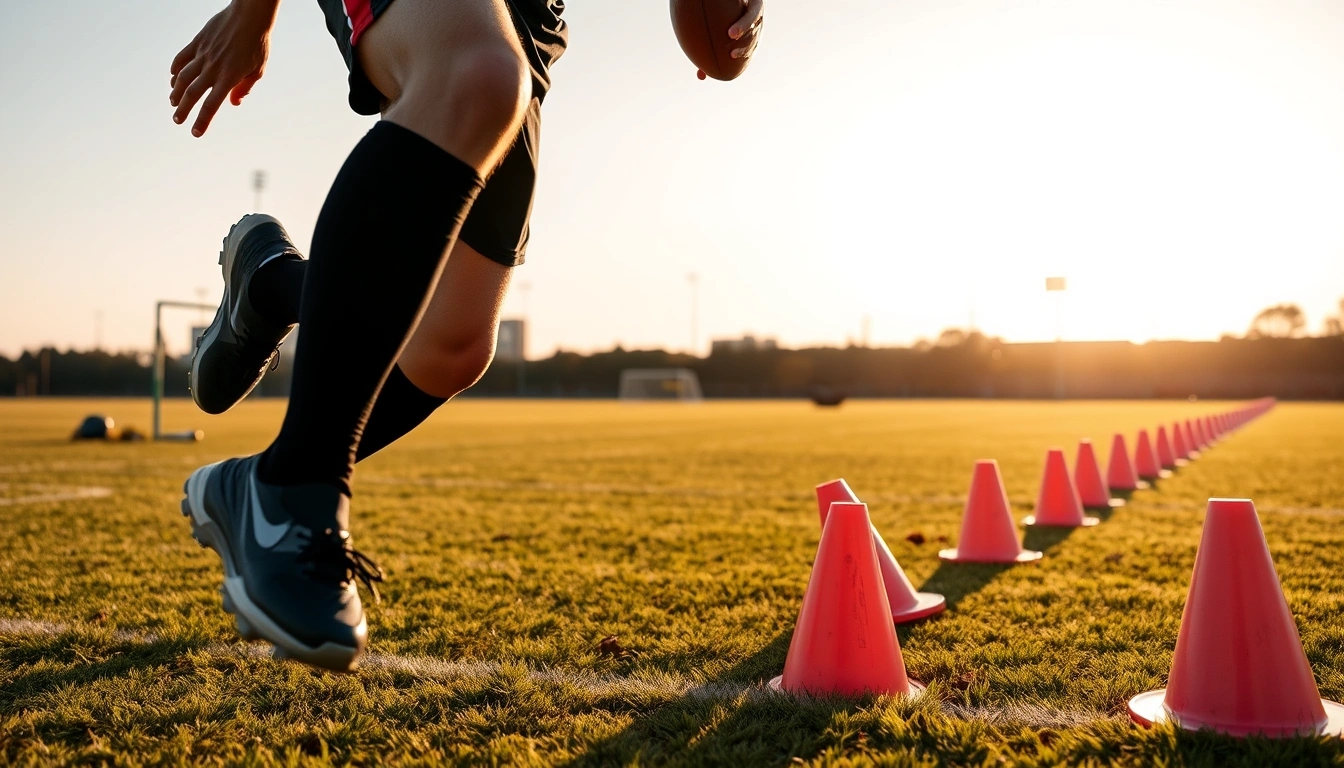
Balancing Strength and Agility
Look, anyone can pump iron and get those tree-trunk legs, but on the football field? It’s a whole different ball game. Sure, leg strength is crucial — no denying that — but if you can’t move like a cat on a hot tin roof, all that raw power won’t do much good. Agility is the real MVP here. It’s the secret sauce that lets you dodge tackles, change directions on a dime, and keep your balance when things get chaotic. So how do you get both? Let’s break it down.
First off, forget the stereotype that strength means slow and bulky. That’s old news. Modern football players need quick feet and explosive power, which means your training has to blend speed, balance, and strength all in one sweaty package. You want drills that don’t just build muscle but also sharpen your reflexes and coordination.
- Quick Feet Ladder Drills: Set up an agility ladder or just mark spots on the ground. The goal? Move your feet lightning fast without tripping. It’s not just about speed but precision — stay light on your toes.
- Single-Leg Balance Exercises: Stand on one leg while tossing a ball or doing mini squats. This forces your stabilizer muscles to kick in, improving balance and joint strength.
- Bounding and Hopping: Think of these as plyometric moves that teach your legs to explode off the ground, which is gold for those sudden sprints or jumps.
| Drill | Primary Benefit | Equipment Needed |
|---|---|---|
| Agility Ladder Drills | Improves foot speed and coordination | Agility ladder or tape markers |
| Single-Leg Balance Squats | Enhances balance and joint stability | None or light dumbbells (optional) |
| Bounding/Hopping | Develops explosive power | Open space |
Now, here’s the kicker: you can’t just do these drills once in a blue moon and expect miracles. Consistency is king. But don’t go overboard — overtraining kills progress and can leave you hobbling on game day. Mix these agility drills with your strength workouts, but give yourself time to recover.
Oh, and one more thing — balance isn’t just physical. Mental agility counts too. Football is fast-paced, and your brain’s gotta keep up with your legs. So throw in some reaction drills, like catching a ball thrown unexpectedly or responding to a coach’s random commands. Keeps you sharp.
Pro Tip:Combine strength and agility drills into circuits for max effect.Example Circuit:- 20 quick ladder runs- 15 single-leg squats (each leg)- 10 bounding jumps- Repeat 3 rounds with 1-minute rest in between
To sum it up — leg strength without agility is like having a Ferrari with no steering wheel. You might have the power, but you’re not going anywhere fast. Build your legs strong, sure, but keep them quick, balanced, and ready to dance around defenders. Because in football, agility isn’t just king — it’s the whole royal court.
Common Mistakes to Avoid When Training at Home
Alright, so you’re pumped to build those powerhouse legs right in your living room or backyard, huh? That’s awesome! But before you dive headfirst into squats and lunges like a maniac, let’s pump the brakes for a sec. Training alone without a coach or gym can be a double-edged sword. Sure, you get freedom and no waiting for machines, but it’s easy to trip up on some rookie errors that not only stall your gains but might also land you in the injury ward. Here’s a rundown of the usual suspects you want to dodge.
- Poor Form: The Silent Progress Killer
It’s tempting to crank out reps fast and furious, but if your form’s off, you’re basically wasting your time. Bad technique can mess with your knees, ankles, or lower back. For example, letting your knees cave inward during squats? Big no-no. It’s like setting a trap for injury. Slow down, watch some tutorial vids, or even film yourself to check your posture. Remember, quality > quantity here. - Overtraining: When More Isn’t Merrier
You might think, “More is better!” but your muscles don’t see it that way. Training your legs every single day without proper rest can cause fatigue, soreness that won’t quit, or worse, stress fractures. Your muscles grow when you rest, not when you grind non-stop. So, schedule those rest days and listen to your body’s subtle (or not so subtle) cries for a break. - Ignoring Warm-Ups and Cool-Downs
Skipping warm-ups is like jumping into a cold pool — shock city for your muscles. Without warming up, you risk strains or pulls. Likewise, cooling down with stretches or foam rolling helps flush out lactic acid and prevents stiffness. Don’t be lazy here; it’s a simple habit that pays dividends.
| Common Mistake | Why It’s Bad | How to Fix It |
|---|---|---|
| Rushing Through Reps | Leads to poor form and injury risk | Focus on controlled, deliberate movements |
| Training Without Rest | Causes fatigue and stalls muscle growth | Plan rest days and listen to your body |
| Neglecting Mobility Work | Increases stiffness and reduces range of motion | Incorporate dynamic stretches and foam rolling |
Now, here’s a little secret that most folks overlook when training solo: progressive overload. Yeah, fancy term, but basically, it means you gotta keep challenging your muscles by upping the difficulty over time. If you’re doing the same 20 bodyweight squats every day for a month, guess what? Your legs are gonna throw a party — but it’s a “no more gains” party. Mix it up with jump squats, pistol squats, or add resistance bands to keep those muscles guessing.
Also, don’t fall into the trap of comparing yourself to that Instagram fitness guru who makes it all look effortless. Everyone’s journey is different, and sometimes, what works for one might wreck another. Be patient and forgiving with yourself. If you feel sharp pain (not the usual burn), stop immediately and reassess. Injuries suck and can bench you for weeks — nobody wants that.
- Not Tracking Progress
Without a coach yelling at you, it’s easy to lose sight of your progress. Keep a simple workout journal or use your phone to jot down reps, sets, or times. Seeing improvements, even small ones, keeps motivation alive and kicking. - Neglecting Nutrition and Hydration
You can’t out-train a bad diet. If you’re skipping meals or not drinking enough water, your legs won’t get the fuel they need to grow and recover. Protein, carbs, and healthy fats are your best friends here.
Quick Checklist to Avoid Slip-ups:- Warm up for 5-10 mins before training- Focus on form over speed- Schedule rest days (at least 1-2 per week)- Add variety to your workouts regularly- Track your progress in a journal or app- Stay hydrated and eat balanced meals- Stop if you feel sharp or unusual pain
So, training at home can be a blast and super effective if you keep these pitfalls in check. Remember, building strong legs isn’t about racing through reps or punishing yourself daily. It’s about smart, consistent effort — and yeah, a little bit of patience (ugh, the hardest part). Stick with it, and soon enough, you’ll be powering down the field like a pro, no gym required.
Tracking Progress Without Fancy Tech
Alright, so you’re grinding away on those leg workouts, no gym membership, no fancy machines, just pure hustle. But how do you actually know if you’re getting stronger? I mean, you can’t just rely on how your jeans fit or how much you hate lunges now compared to last week, right? Tracking progress without high-tech gadgets might sound like a drag, but trust me, it’s totally doable — and even kinda fun if you get creative.
First off, forget about needing some expensive fitness tracker or a gym app. You’ve got your own body and a bit of old-school determination. Here are some simple, no-nonsense ways to keep tabs on your leg strength improvements:
- Rep Counts and Sets: Keep a workout journal. Yes, an actual notebook or a note app on your phone works wonders. Write down how many squats, lunges, or step-ups you do each session. If you started with 10 squats and now you’re breezing through 20, that’s progress right there.
- Timed Holds and Planks: For exercises like wall sits or single-leg balances, track how long you can hold the position. If you can push past your previous time, that’s a win.
- Jump Height Measurement: No fancy jump mat? No problem. Mark a wall with chalk or tape at your standing reach height, then jump and touch as high as possible. Measure the difference between your standing reach and jump reach. Repeat every couple weeks and watch those inches climb.
But hey, numbers aren’t everything. Sometimes your legs just feel stronger or more stable on the field — which is also a solid sign. Still, if you want some structure, here’s a quick progress tracking table you can steal:
| Exercise | Week 1 | Week 3 | Week 6 | Notes |
|---|---|---|---|---|
| Bodyweight Squats (reps) | 15 | 25 | 35 | Feeling less wobbly |
| Wall Sit (seconds) | 30 | 45 | 60 | Burns like crazy! |
| Vertical Jump (inches) | 12 | 14 | 16 | Improving fast |
Another pro tip? Record yourself doing exercises every now and then. Watching your form improve or spotting weaknesses you didn’t notice can be a game changer. Plus, it’s oddly satisfying to see your gains in action, even if you’re just doing lunges in your backyard.
And hey, don’t get too obsessed with tracking every little detail. Sometimes progress is slow, and your legs might feel like jelly after a tough session. That’s normal. The key is consistency — keep showing up, keep pushing, and eventually, those improvements will stack up.
So, no gym? No fancy tech? No excuse. Grab a pen, a stopwatch, or just your own body, and start keeping track. Your legs — and your football game — will thank you.
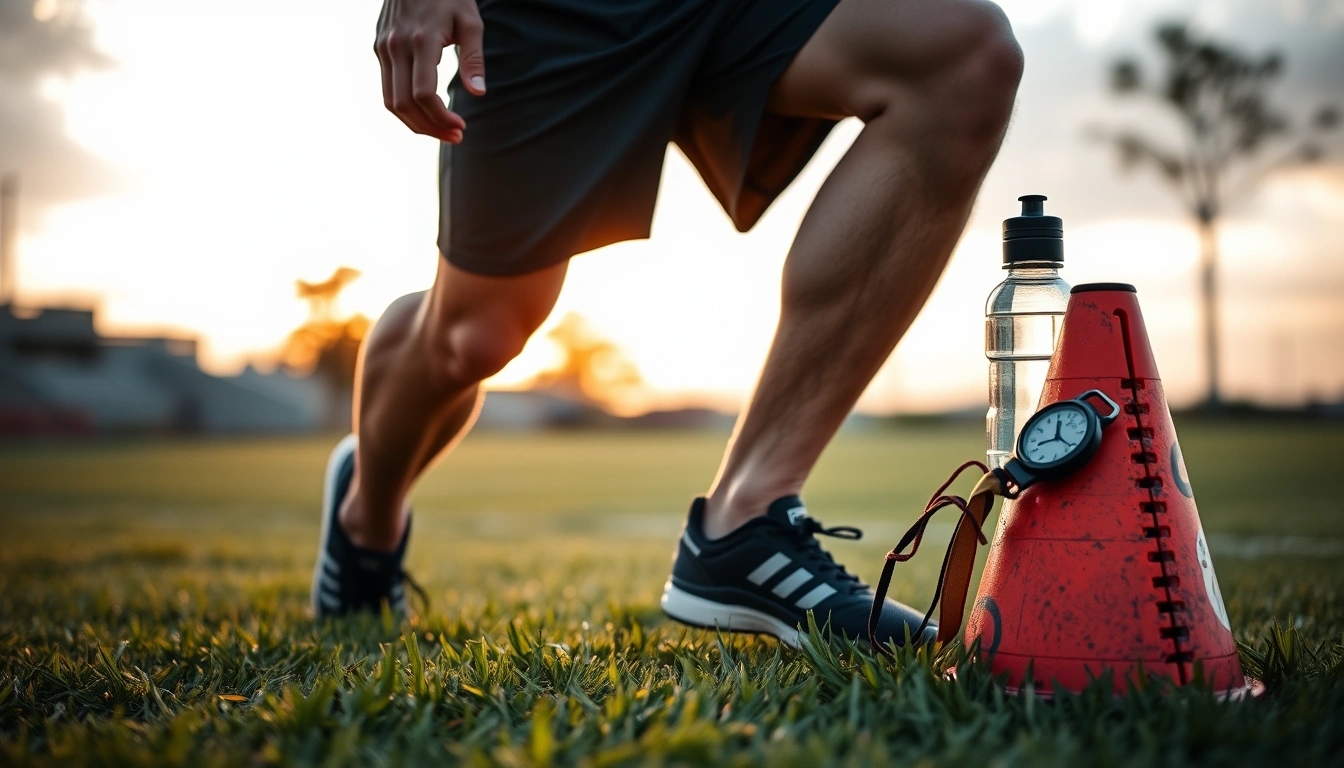
Setting Realistic Goals and Staying Motivated
Alright, let’s get real for a second — building stronger legs without a gym isn’t exactly a walk in the park. It’s more like a slow, steady climb up a hill that sometimes feels like it goes on forever. But hey, if you’re serious about this, the first thing you gotta do is set goals that don’t make you want to throw in the towel after day two.
Start Small, Think Smart
Trying to jump from zero to hero overnight? Nah, that’s a recipe for disappointment. Instead, break down your leg strength journey into bite-sized chunks. For example, aim to nail 20 perfect bodyweight squats in a row by the end of week one. Then, maybe add lunges or step-ups the following week. These little wins keep you pumped and less likely to quit.
| Goal Type | Example | Why It Works |
|---|---|---|
| Short-Term | Complete 3 sets of 15 lunges without wobbling | Builds confidence and habit |
| Mid-Term | Increase jump height by 2 inches in 4 weeks | Tracks measurable progress |
| Long-Term | Run a mile with stronger, less tired legs | Focuses on overall endurance and strength |
Keep Your Eyes on the Prize (But Don’t Obsess)
Motivation is a tricky beast. One day you’re crushing it, next day you’re wondering if your legs are made of jelly. Totally normal! The trick is to mix things up — swap exercises, try jump training, or even throw in some resistance bands to keep boredom at bay. Remember, the journey has ups and downs, so don’t beat yourself up if you miss a workout or two.
- Celebrate small victories: Did you do one extra rep? High five yourself.
- Find a workout buddy: Accountability partners make a huge difference.
- Track progress visually: Keep a journal or use a simple chart to see how far you’ve come.
Patience Is Your Best Friend
Look, nobody’s gonna wake up tomorrow with tree-trunk legs just because they did 100 squats today. Muscle building is slow, especially without fancy gym equipment. But that slow and steady approach? That’s where the magic happens. Trust the process, even when it feels like you’re crawling.
Tips for Staying Motivated:- Set weekly mini-goals- Mix in fun exercises (dance, jump rope)- Reward yourself (pizza night, anyone?)- Remember why you started- Don’t compare yourself to others
In the end, building stronger legs without a gym is less about instant results and more about consistency, patience, and a sprinkle of creativity. So lace up those trainers, set those realistic goals, and keep pushing — your future self will thank you.
Frequently Asked Questions
- Can I really build strong football legs without any gym equipment?
Absolutely! Your own body weight is a powerhouse when it comes to building leg strength. Exercises like squats, lunges, and step-ups target all the major muscles in your legs and can be done anywhere. Plus, adding jump training and resistance bands can crank up the intensity without needing a gym.
- How important is nutrition in leg strength development?
Nutrition is like fuel for a high-performance engine—skip it, and you stall. Eating enough protein, healthy carbs, and essential fats helps repair and grow your muscles after workouts. Don’t forget hydration and possibly supplements like creatine or BCAAs to speed recovery and boost gains.
- What’s the best way to recover after intense leg workouts?
Recovery isn’t just a break; it’s when the magic happens. Stretching, foam rolling, and getting quality sleep are your secret weapons. These help reduce soreness, improve flexibility, and prepare your legs for the next explosive session.
- How do jump training exercises improve football performance?
Think of jump training like adding a turbocharger to your legs. Plyometrics increase explosive power and speed, which are crucial for quick sprints, sudden stops, and powerful tackles on the field. Even a small backyard can become your personal launchpad.
- Are resistance bands really effective for leg workouts?
Don’t underestimate these stretchy tools! Resistance bands add constant tension throughout movements, helping build strength and stability. They’re perfect for targeting smaller muscles and improving balance without bulky weights.
- How can I avoid injury when training legs at home?
Form is king. Poor technique or overtraining are the fastest routes to injury. Always warm up, focus on controlled movements, and listen to your body. If something hurts beyond normal muscle fatigue, it’s time to rest or adjust your routine.
- What’s a simple way to track my leg strength progress without fancy tech?
Old-school methods work wonders! Keep a workout journal noting reps, sets, and how you feel after exercises. You can also use simple tests like timing sprints or counting jump height to see improvements over time.
- How do I stay motivated when building leg strength without a gym?
Set small, achievable goals and celebrate every win, no matter how tiny. Mix up your workouts to keep things fresh, and remember why you started—stronger legs mean better performance on the field. Consistency beats intensity every time!

